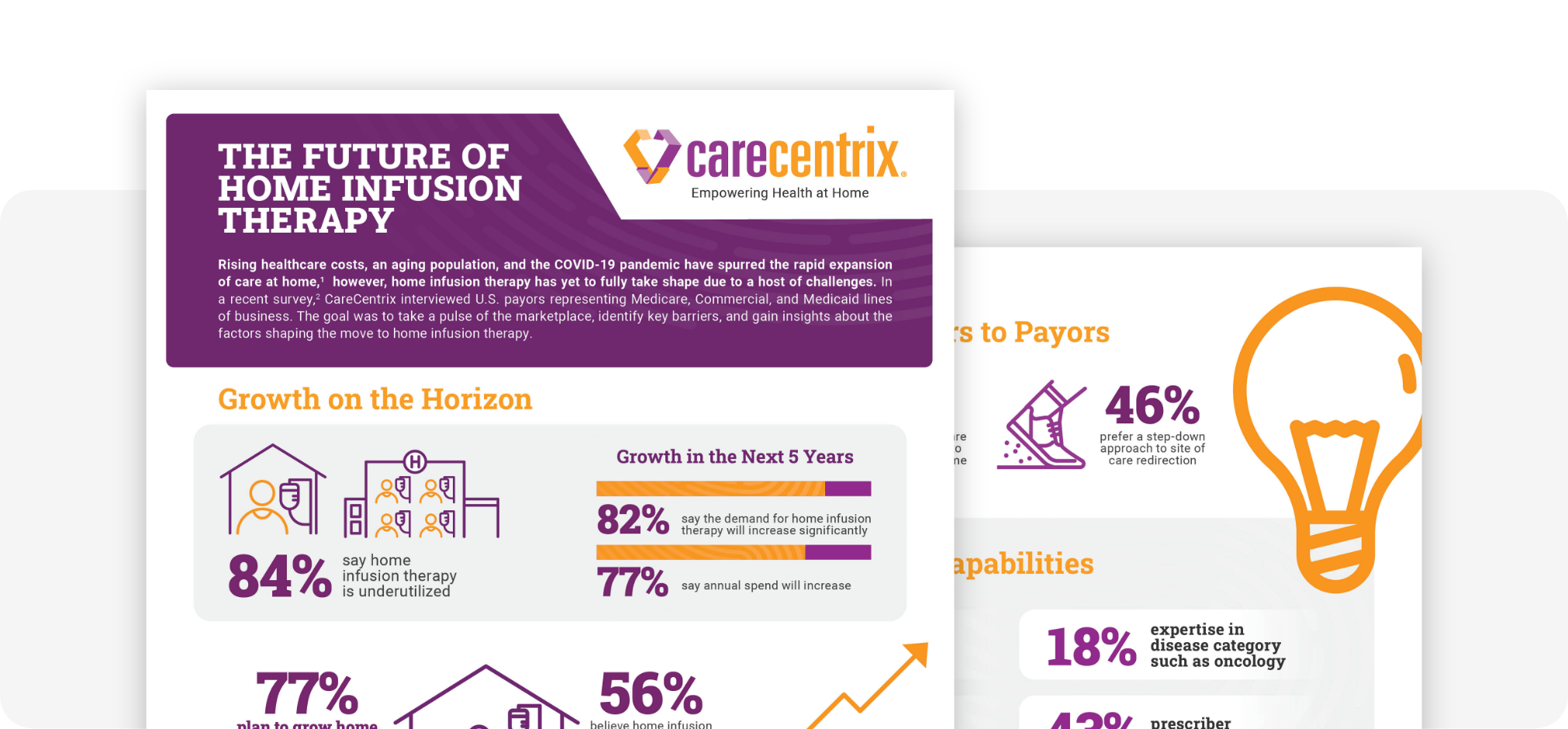
In the United States, the population is growing and living longer, with the CDC projecting a nearly 50% increase in cancer cases by 2050.1 This correlates to 1 in 3 people being diagnosed with cancer in their lifetime2—highlighting the urgent need for innovative, member-centered solutions that improve cancer care delivery while addressing the logistical, financial, and emotional burden on members and their families.
At the same time, cancer care remains one of the most costly and complicated aspects of the healthcare system. Health plans are facing the dual challenge of trying to manage rising drug and treatment costs while also ensuring their members are receiving high-quality care.
Cancer care is already a top cost driver for health plans3, but by 2030, cancer-related healthcare spending is projected to reach $246 billion.4
Fortunately, new cancer care models are emerging that are poised to improve access, quality, and outcomes while also providing more flexibility for members and reducing costs.
How Traditional Cancer Care Models Fall Short
Cancer care in the United States is often complex, fragmented, and highly variable from member to member. Coordinating across multiple specialists, navigating various treatment modalities, and managing intricate medication regimens all add layers of difficulty.
Traditional cancer care models struggle to keep pace, creating barriers that affect access, drive up costs, and limit outcomes. Key challenges include:
- One-Size-Fits-All Approach: Rather than focusing on members and delivering whole-person care that addresses their unique needs, existing models focus primarily on the delivery of treatment, not on the patient receiving the treatment.
- Lack of Flexibility: Since cancer care is typically delivered in a hospital or outpatient facility, members don’t have much choice in the way of receiving services that are convenient, easy to access, and in a more comfortable environment.
- Health Risks: Infection is one of the most common complications of cancer and treatment.5 Receiving cancer care in a hospital setting increases a member’s risk for respiratory illnesses, opportunistic infections, and other healthcare-associated infections (HAIs).
- Cancer Disparities: Access to cancer care remains limited for many, especially for those living in rural or underserved communities. When combined with social determinants of health (SDoH), these barriers can make treatment even harder to obtain. Members may face challenges such as unreliable transportation or the need to miss work to attend appointments, creating not only inconvenience, but also lost income, financial strain, and lack of adherence to prescribed treatment regimens.
- Cost of Treatment: While immunotherapy has been a clinical breakthrough in cancer care, it comes at a high price. Delivering infusions in a hospital setting averages around $131,000 per member per year.6 With 36% of individuals with cancer eligible for immunotherapy7, the cost of treatment can place substantial pressure on a health plan’s financial performance.
Moving Cancer Infusion Therapy to the Home
Research shows that administering cancer treatments at home is not only safe, but it can also improve outcomes8 and reduce overall healthcare costs.9 Delivering care in the home also minimizes the risk of respiratory illnesses and hospital-acquired infections by limiting exposure to clinical environments.
As members continue to seek more personalized and comfortable health care experiences, the home remains a preferred site of care, and cancer care is no exception.
73% of members would prefer to receive infusion treatment in their homes rather than in a hospital setting.10
CareCentrix’s New “Oncology at Home” Solution for Health Plans
To help health plans meet growing member needs and combat rising costs, CareCentrix recently launched its Oncology at Home solution, a first-of-its-kind, end-to-end care coordination solution specifically for immunotherapy infusions.
Our solution seamlessly integrates with existing oncology programs to optimize site of care strategies—shifting immunotherapy from high-cost hospital settings to more member-friendly environments like outpatient infusion centers or home-based care.
Oncology at Home addresses many challenges of traditional cancer care models and enables equitable access to high-quality, compassionate care that improves the member experience and reduces costs. We achieve this through:
- Utilization Management (UM) Delegation: Through our UM process, we ensure members receive the appropriate services and level of care in alignment with health plan guidelines and recommended timeframes. We also work with the health plan to define the clinical benefit for medical coverage guidelines (MCG) to authorize services to the appropriate site of care, including home, ambulatory infusion centers (AIC), or ambulatory infusion suites (AIS).
- Home Infusion Provider Network: We curate and manage a network of high-quality home infusion providers who are experienced in the administration of immunotherapy drugs and are well-equipped to manage any adverse reactions or complications that may arise during the infusion. Our large national footprint allows for access to care, including in rural and underserved areas. We also offer the flexibility to use a health plan’s existing network.
- Active Drug Pipeline Monitoring: Our team identifies new immunomodulation therapies (IMTs) suitable for alternative care settings, including home, AIC, or AIS. We evaluate each therapy for safety and operational feasibility using FDA labeling and national clinical guidance such as National Comprehensive Cancer Network (NCCN), American Society of Clinical Oncology (ASCO), Oncology Nursing Society (ONS), and trusted industry resources such as the National Home Infusion Association (NHIA) and NHIF’s peer-reviewed Infusion Journal. Additionally, we collaborate closely with our health plans to stay aligned with their coverage determinations, so that eligible therapies can be added to the program fee schedule and operationalized in a timely fashion.
- Monitoring and Reporting: We continuously monitor authorization data, adverse events, medication adherence, and infusion reactions, translating these insights into real-time interventions that safeguard patients and strengthen outcomes. This helps keep our program safe, effective, and transparent for both members and health plans.
Our Oncology at Home solution delivers personalized cancer care in comfortable, convenient settings—combining enhanced safety protocols with supportive care models that improve adherence, strengthen outcomes, and reduce costs.
The value becomes even clearer when looking at cost savings data. Transitioning an eligible member receiving Keytruda infusions from the hospital to home can yield 66% in cost savings per year—driving $86,000 in annual savings per member.6 Our estimates also show that when the same infusion is moved from the hospital to an AIC or AIS, the result is $49,000 in annual savings per member.6
Cancer Care at Home is the Here and Now
With cancer cases on the rise and health care costs climbing, health plans need innovative solutions that deliver personalized care, manage the high cost of immunotherapy, and keep members at the center of care. This isn’t the future of healthcare; it’s here now.
For nearly 30 years, CareCentrix has been a trusted leader in home infusion therapy services, coordinating more than 120,000 home infusions annually.11 Building on this deep expertise, we are extending our capabilities to help members with cancer access safe, high-quality, and convenient care at home.
Discover how our Oncology at Home solution can help your organization unlock meaningful cost savings by transitioning immunotherapy to lower cost settings, while ensuring every member receives personalized, effective care. Schedule a consultation to learn more today.
Sources:
- Centers for Disease Control and Prevention, 2021.
- American Cancer Society, 2025.
- Centers for Disease Control and Prevention, 2024.
- Cancer Epidemiol Biomarkers Prev., 2020.
- American Cancer Society, 2024.
- 2024 Truven State of Florida Data. Average costs per member based on averages from three widely used immunotherapy drugs: Keytruda, Tecentriq, and Opdivo. Savings may vary by population and in-scope drug list.
- JAMA Network Open, 2020.
- Blood, 2020.
- National Home Infusion Association, 2023.
- Journal of Clinical Oncology, 2025.
- 2024 CareCentrix book of business performance data.
EDRC 2336 092025





